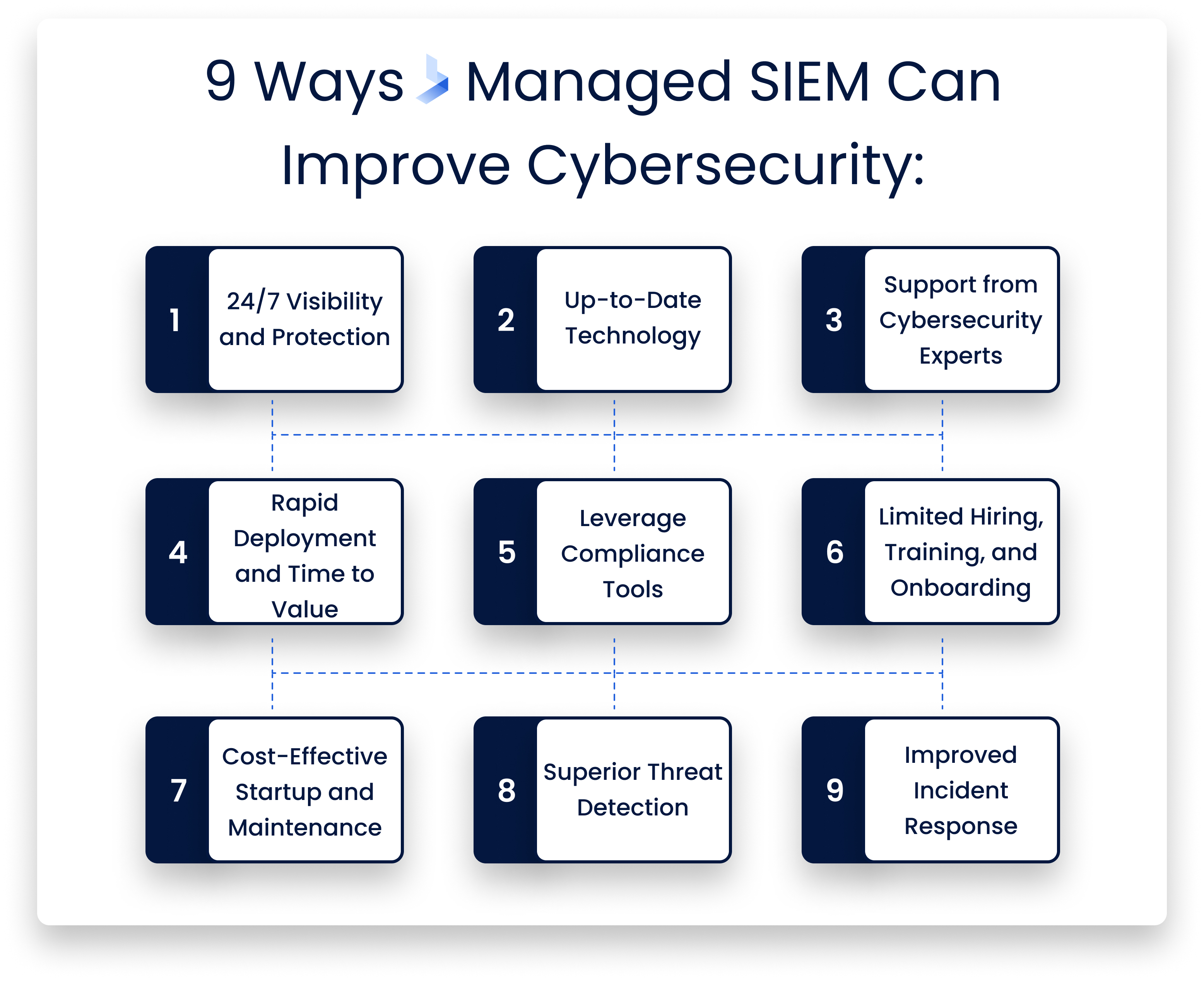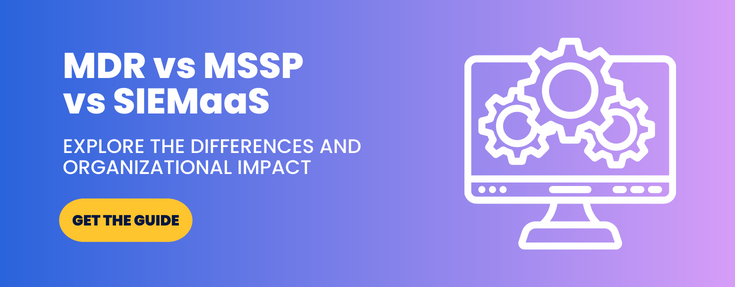How Can Managed SIEM Help Secure My Company Against Cyberattacks?

Cybersecurity is rapidly becoming one of the largest concerns for business leaders across all industries. Companies and organizations hoping to improve business relationships, attract more clients and continue to grow in today's modern business environment understand technology is essential. Yet, operational technology, remote devices, and extended supply chains can reveal new vulnerabilities that leave your network open to attack. As the cyberattacks surface continues to grow for businesses of all sizes, finding a comprehensive solution for detecting threats is as necessary as a physical lock on the door of a brick-and-mortar establishment.
Security Information and Event Management (SIEM) is a crucial part of modern cybersecurity efforts. Yet, it can be challenging to understand how the technology works and the efforts required to manage the complex system. Security vendors supply different offerings and the needs of one organization can differ dramatically from another company within the same industry. Learning more about SIEM technology and the potential it has for detecting and responding to sophisticated threats can help you make an informed decision about the best way to secure your company against cyberattacks. For many organizations, managed SIEM provides superior 24/7 protection against all types of sophisticated cyberattacks. Your MSSP's cybersecurity professionals act as an extension of your team, whether you need full-time monitoring or services that work alongside your existing security team.
What Is Managed SIEM?
SIEM is the technology that collects and manages information about the events that occur within your network. A modern SIEM system should have the capability to offer a centralized view of IT security by ingesting log and event data from a range of security tools, hardware, and applications. Today's technology allows software developers to implant machine learning into the software that will help your SIEM establish baseline behavior and recognize suspicious behavior when it occurs within your network. From there, the system can be optimized to send out automated alerts to specific personnel when a potential security risk occurs.
At its core, SIEM is software designed to provide full visibility into your network and detect and respond to cyberattacks. In reality, SIEM software is only a single part of your SIEM system which requires hardware, infrastructure, and trained professionals to run. Organizations that operate an on-premise SOC might have some or all of these mechanisms in place. Still, few organizations have the capability to offer 24/7 protection.
Managed SIEM is an alternative to on-premise deployment, setup, and monitoring of SIEM software. Whether you have in-house or cloud-based SIEM, managed SIEM utilizes services from a third-party service provider to host your SIEM application and monitor your organization's network. Although some businesses fear that managed SIEM will take cybersecurity out of their hands, it's actually a choice that allows an organization to take as much or as little control of their SIEM solution as desired. With options ranging from a fully-managed solution that provides technology, software, and is completely optimized and monitored by your provider to co-managed solutions that can be customized to help you eliminate potential security gaps, managed SIEM providers act as an extension of your IT security team to provide you with a comprehensive solution to full-time protection.

9 Ways Managed SIEM Can Improve Cybersecurity
In the midst of a pandemic and record-breaking changes in the job market, cybersecurity concerns still managed to make headlines in 2021. Cyberattacks that affected government agencies, healthcare facilities, major corporations, and vital infrastructure became top news stories. Thousands more cyberattacks targeted small and medium businesses, schools and universities, smaller towns, and a variety of other institutions went unnoticed by the general public. As operational technology continues to grow and companies address the demand for long-term hybrid workplaces, dependence on technology will continue to grow, and the cyberattacks surface will grow along with it. Sophisticated attacks from modern-day hackers require high-level tech knowledge and the ability to navigate unfamiliar networks without being detected.
While software and other technologies are used to launch such attacks, the actions driving sophisticated cyberattacks are uniquely human. Experienced cybersecurity professionals learn to think like attackers and use SIEM technology to automate the detection of the slow and low cyberattacks that frequently help attackers achieve their objectives. Managed SIEM combines some of the most up-to-date technology with the knowledge of highly trained professionals to provide organizations with a service that acts as the core of a highly effective modern cybersecurity solution. Managed SIEM offers these benefits that can elevate your cybersecurity posture beyond the capabilities of technology and software alone.
24/7 Visibility and Protection
In 2017, thousands of hospitals and surgeries across the United Kingdom on Friday before Mother's day, due to the WannaCry attack. The SolarWinds hack was detected on a Sunday in December 2020. The ransom note that prompted the immediate shutdown of the Colonial Pipeline occurred on the Friday before Mother's Day in 2021. The ransomware attack on JBS foods occurred on Sunday before Memorial Day 2021. Bad actors don't work regular business hours. They attack a network at the moment it's most vulnerable to ensure successful entry and the amount of time they need to get to their objective without detection. In other words, a company with a fully staffed on-site SOC that works regular business hours still has the potential to fall victim to cyberattacks during off-hours.
Your cybersecurity experts are highly trained individuals who keep your business network safe from hundreds of cyberattacks each week. However, these professionals are humans who sleep, get sick, and take vacations. While the trained cybersecurity professionals that run the off-site SOC for your MSSP are also human, security providers have a robust staff of professionals prepared to protect organizations 24/7, 365 days of the year. Your MSSP's cybersecurity professionals act as an extension of your team, whether you need full-time monitoring or services that work alongside your existing security team.
Up-to-Date Technology
Cybercrime changes at the speed of technology. Technology is a critical part of any cybersecurity solution. Unfortunately, new technology becomes outdated quickly. Just like your new smartphone or operating system update, your security tech stack will become outdated along with improving technology and new cyberthreats. For organizations depending solely on an on-premise SIEM, this means purchasing new software and infrastructure and continually updating your system. These costs are often sudden and unexpected, or expensive and must be worked into a complicated budget. Even worse, putting off updates or new technology could leave your network open to attack, costing you significantly more.
On the other hand, managed SIEM is based on a subscription that includes up-to-date technology that is implemented, monitored, and updated by your MSSP. This means for a predictable monthly cost, you always have the most up-to-date technology protecting your system. If you're not sure the newest tech will make a difference to your level of protection, consider the advanced level of protection offered by Next-Gen SIEM in comparison to past versions.
- Reduction in false alerts due to UEBA and machine learning
- Cloud-based SIEM that offers the faster distribution of intelligence, improved endpoint protection, and the ability to process large volumes of log data
- Integration with compliance requirements for management of common compliance requirements like HIPAA, FISMA, GLBA, CMMC, and FERPA.
- Customized dashboards for complete visibility into your network along with dashboards and reports that fit your unique environment
- Machine learning and UEBA that can detect advanced insider threats
- AI for automated incident response to quickly mitigate threats with minimal damage
Consistent and Ongoing Support From Cybersecurity Experts
SIEM is one of the most hands-on tools in any cybersecurity solution. An in-house SIEM solution will require internal resources and security personnel to properly set up, manage, monitor, and optimize your SIEM system to meet the needs of your organization. For your internal team, this can lead to alert fatigue and fractured focus. An established MSSP has an existing staff of educated, trained, and experienced subject matter experts. These professionals act as members of your security team to optimize your SIEM tools for superior performance-tuned to your environment. An off-site SOC is one of the biggest advantages of managed SIEM.
Upon deployment, your SIEM system must be customized to your environment to achieve full capability. When you invest in managed SIEM, experienced security analysts and engineers deploy and optimize tools they already use successfully across different environments. This experience means your MSSPs team can offer advice that your team may not consider on their own.
Even long after optimization, monitoring your SIEM is a time-consuming process that requires intense focus. When companies depend on IT specialists or short-staffed security teams to handle these tasks, fractured focus can result in distraction that leads to undetected breaches and cyberattacks. Whether you depend on a third-party SOC for a co-managed SIEM or a fully managed solution, you gain the advice of a seasoned team of experts that can help you get the most out of your SIEM.
Rapid Deployment and Time to Value
SIEM is not an out-of-the-box tool ready for complete functionality. It's a complex system designed to be customized to your environment and integrated with all the applications, platforms, and third-party tools you utilize within your network. This means your investment will not be a fully functional solution immediately upon deployment. Even if you have a fully staffed on-site SOC, deploying and optimizing complex SIEM tools is a challenge for a team unfamiliar with the technology.
Established MSSPs typically depend on a preferred SIEM system. Therefore, your MSSPs cybersecurity team has considerable experience in the complex task of SIEM deployment and optimization. A successful SIEM optimization takes time. While Next-Gen SIEM has machine learning capabilities, the system must be told how to work in your organization's environment. While your managed SIEM will still take some time to deploy and optimize, the experienced team will have the knowledge to provide a faster deployment process while correctly customizing it to your network. Conversely, a team with no previous experience with the software will be forced to take a trial and error approach.
Limited Hiring, Training, and Onboarding
SIEM solutions require professional security personnel for constant tuning and monitoring. Both fully managed and co-managed SIEMs make these professionals available which makes a drastic difference in the effort it takes to manage your SIEM. During an ongoing cybersecurity talent shortage, recruiting and retaining cybersecurity professionals is a challenge. Managed SIEM takes much of the work of hiring and training out of your hands.
If you're setting up an on-prem SIEM, you'll be responsible for hand picking, onboarding, and training every employee. With a managed SIEM, you'll be selecting a dependable company that already has trained specialists on hand. Hiring is reduced to a single choice, onboarding is limited to introducing analysts and engineers to your network, and training is virtually eliminated.
Cost-Effective Startup and Maintenance
Running your own on-premise SIEM is expensive. It requires you to buy SIEM tools and the necessary storage and hardware to assemble and monitor logs from every single data collection point on your system. You'll also need a full team of professionals to install, deploy, optimize, and monitor the system. After taking several months to tailor the system to your business, your team will be responsible for keeping the system and all related infrastructure updated.
A managed SIEM operates with a predictable monthly cost for cloud-based infrastructure, storage space, and knowledgeable staff. Ongoing maintenance, support, and updates are all worked into the contract. This means an organization can factor complete SIEM protection into their security budget without adding the prohibitive cost of expensive infrastructure and storage space. By eliminating the lengthy configuration time required by an in-house system, you reduce the costs associated with deployment. Managed SIEM can be configured in days or weeks instead of months, reducing onboarding costs and potential security risks. Since ongoing support is also part of the package, updates and scaling are cost-effective as well.
Managed SIEM is updated by your provider. With unlimited cloud-based storage capabilities, you can scale your SIEM at the speed of company growth without needing to invest in on-site hardware and tools. Overall, managed SIEM takes care of many of the bulk costs associated with implementation and ongoing management with less expensive cloud-based infrastructure and a fully trained staff. Organizations are able to maintain a predictable payment plan that eliminates surprises and changing costs.
Superior Threat Detection
The threat landscape is constantly evolving. While companies are aware of many of the risks, it's impossible to keep up with all of the vulnerabilities threat actors are able to exploit. A dependable MSSP works with a variety of organizations and businesses across several industries. With this experience and reach, security providers have the capability to develop a network of real-time threat intelligence sources to pass on to their clients.
Tools like User and Entity Behavior Analytics (UEBA), intelligence threat feeds, and threat chain-based model alerting allow your managed SIEM provider to incorporate intelligence from multiple sources for improved threat detection. When these tools are properly deployed and optimized during the installation of your SIEM and monitored around the clock by trained security experts, the detection time of new and emerging threats is significantly minimized.
Improved Incident Response
Your IT specialists are experts with the tools and processes used to run your network. Your MSSPs specialists are experts in advanced, evolving, and emerging threats as well as the tools used to mitigate these threats. A managed SIEM allows these two teams to work together to provide the most effective security options available.
The amount of log data generated from a SIEM system is substantial. Responding to potential threats requires data analysts to pour over large amounts of unrelated data to find connections or suspicious behavior. Even worse, a SIEM that isn't fully optimized is likely to trigger a deluge of false alerts, contributing to reduced focus due to alert fatigue. The nature of SIEM means an in-house team will force engineers to spend most of their time focused on reviewing logs instead of focusing on the vital tasks of response and remediation.
Managed and co-managed SIEM take routine tasks off your team's plate so they can focus on real-time threats. Your MSSP's off-site SOC reviews every SIEM alarm to determine which ones are actionable and provide swift and effective responses to threats as they arise. As subject matter experts, your MSSPs team members are prepared to provide a rapid, streamlined response to relevant threats with preconfigured tools and infrastructure that is already in place. Previous experience with incident response tools accelerates the process for the most efficient response and remediation to minimize damage during an active attack.
Superior Integration
For complete protection, every application, platform, and device used by your organization must be included. Modern technology allows businesses to make connections and complete tasks more rapidly than ever before. This is often accomplished through the use of cloud platforms and third-party applications and services. Unfortunately, any connection your organization makes outside of your network presents a potential point of vulnerability. This is why it's essential for your SIEM system to monitor all cloud services and third-party platforms accessed by your network users.
Commonly used third-party platforms and applications are a magnet for threat actors seeking ways to expose vulnerabilities. For instance, many businesses depend on Microsoft Office 365. Attackers know that exposing vulnerabilities within this third-party platform can provide access to multiple organizations instead of seeking entry points for a single business. While third-party software and platforms may have embedded security capabilities and settings, it can be difficult to manually log and monitor the activity of your network users on third-party platforms like O365. Furthermore, separating your security logs and efforts fragments your security efforts and can lead to redundant alerts or lateral movement through your network going undetected.
Luckily, most SIEM systems are designed to integrate with other services to provide seamless visibility into your network. However, making these connections with an in-house SIEM can be difficult. First, your team must take the responsibility of finding SIEM technology that integrates with the platforms and apps used by your organization. After integrations are connected during optimization, specialists spend considerable time providing feedback to reduce false alerts and establish a baseline for normal behavior. Even when these tasks are performed successfully, it's essential to update integrations routinely for optimal performance.
Managed SIEM systems provided by established MSSPs utilize the most up-to-date technology and maintain these connections as part of an ongoing service. In-house teams are forced to depend on updates provided by the platforms they use and increasing investments in relevant tools and software packages. If left waiting for a crucial platform update, the network could be exposed to evolving vulnerabilities the organization would otherwise be protected against.

Managed Next-Gen SIEM Provides Superior Protection Against All Types of Cyberattacks
Cybersecurity protects your business, your devices, your information, your reputation, your employees, and your clients. A managed SIEM solution can save your organization a significant amount of money, resources, and time. Most importantly, it can provide you with the most effective threat detection and response against modern sophisticated cyberattacks. Managed SIEM works to decrease your IT team's workload while cutting costs and improving your overall security posture for improved protection and security compliance.
SIEM isn't just a single function tool designed to offer a single out-of-the-box capability. It's a crucial system that utilizes professional optimization and monitoring to provide complete visibility into your network's continual flow of traffic. As a vital part of your organization's defense against the ever-evolving world of cybercrime, SIEM will never be a set it and forget it tool. Managed SIEM provides your organization with the ongoing support you need to keep up with the speed of changing technology. Need help managing your SIEM? Schedule a demo to learn how managed SIEM services can improve your cybersecurity efforts.
